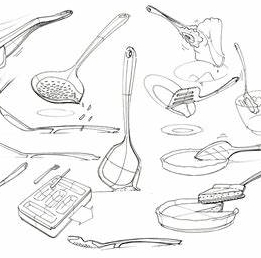When designing kitchen utensils, structure plays a crucial role in functionality, durability, and aesthetics. As a buyer looking to create custom kitchenware, understanding the variety of structural possibilities opens doors to innovative products that stand out in the market. Below, we explore different design structures for kitchen utensils and how they cater to specific needs.
1. One-Piece Molded Structures
- Description: The utensil is crafted from a single piece of material, typically silicone, stainless steel, or plastic.
- Benefits:
- No joints or seams, making it easy to clean and highly hygienic.
- Durable and resistant to breakage.
- Common Applications: Silicone spatulas, stainless steel spoons, and slotted turners.

2. Multi-Part Assembled Structures
- Description: These utensils consist of separate parts assembled together, such as a handle and a functional head.
- Benefits:
- Allows for material customization (e.g., stainless steel head with silicone handle).
- Offers ergonomic design flexibility.
- Common Applications: Whisks, tongs, and peelers.
3. Collapsible or Folding Structures
- Description: Utensils designed to fold or collapse for easy storage.
- Benefits:
- Space-saving, ideal for compact kitchens.
- Often lightweight and portable.
- Common Applications: Collapsible strainers, folding measuring cups, and travel-friendly utensils.
4. Interchangeable Head Structures
- Description: Utensils with detachable heads that can be swapped out for different functions.
- Benefits:
- Multifunctionality reduces the number of tools needed.
- Customizable based on cooking needs.
- Common Applications: Multi-functional spatulas and whisk sets.
5. Ergonomic Curved Structures
- Description: Utensils designed with curves or angles to enhance grip and reduce wrist strain.
- Benefits:
- Improved user comfort during extended use.
- Often recommended for users with joint issues.
- Common Applications: Ladles, vegetable peelers, and specialty knives.
6. Weighted or Balanced Structures
- Description: Utensils designed with evenly distributed weight or weighted handles.
- Benefits:
- Ensures better control and precision.
- Prevents utensils from tipping or slipping into pots.
- Common Applications: Chef’s knives and high-end ladles.
7. Textured or Grip-Enhanced Structures
- Description: Handles or surfaces feature textured patterns to prevent slipping.
- Benefits:
- Enhanced grip even with wet or greasy hands.
- Provides a modern or industrial aesthetic.
- Common Applications: Silicone-handled spatulas, tongs, and mixing spoons.

Design Tips for Buyers
- Material Selection: Match structure with materials that best suit the intended use and market preferences.
- User Experience: Consider how ergonomic design impacts ease of use and customer satisfaction.
- Aesthetic Appeal: Think about color schemes and surface finishes (matte vs. glossy) to align with brand identity.
- Market Trends: Stay updated on trends like eco-friendly materials or minimalist designs.
By exploring these varied utensil structures and design principles, buyers can craft unique products that delight customers and elevate cooking experiences. Whether focusing on sleek, one-piece designs or versatile, multi-functional tools, thoughtful structure choices set your kitchen utensils apart from the competition.

